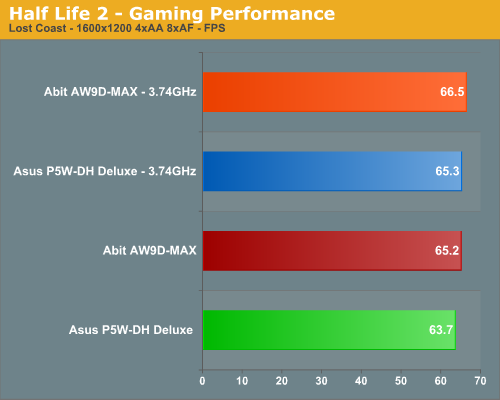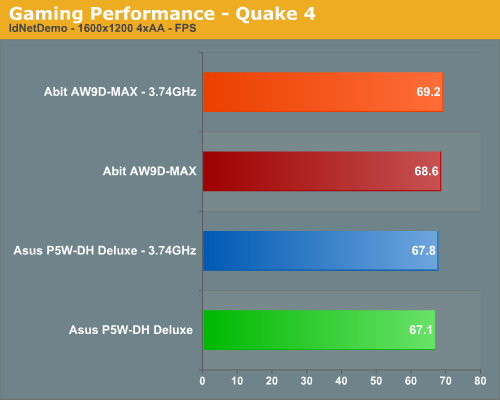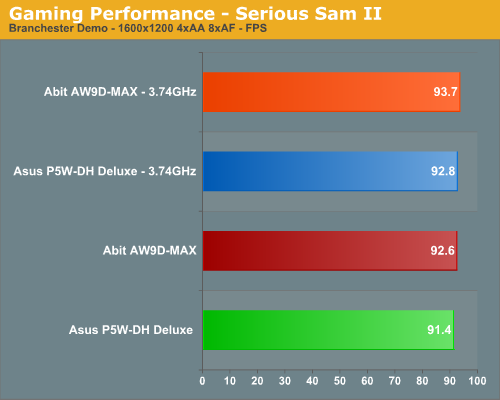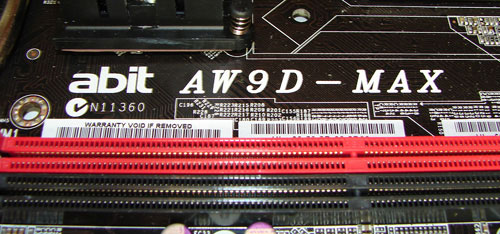Abit AW9D-MAX: When "Beta" MAX is a good thing
by Gary Key on September 8, 2006 3:10 AM EST- Posted in
- Motherboards
High-Resolution Gaming Performance
For high-quality gaming performance, we also tested at 1600x1200 with 4xAA /8xAF. As just about anyone familiar with current games can tell you, benchmarking with a single high-end graphics card at these stressful settings will make just about any recent game GPU limited. That brings up one of the flaws with Intel's 975X chipset as it does not "officially" support NVIDIA SLI and these users will have to look for another solution. At this time that solution is the 7950GX2.
This card works fine on the 975X chipset except for a couple of anomalies in our test scores on the ASUS board that is under investigation currently. The charts below only includes single GPU performance using a 7900 GTX currently, but you can refer to our Conroe Buyers Guide results to see the performance improvements that SLI/CrossFire and a E6700 bring to the table. We will update our results with the 7950GX2 shortly and will have ATI CrossFire results in our next 975X review.



If you're serious about gaming at a high resolution with all the eye candy enabled, you will most certainly want to run a multi-GPU configuration (with NVIDIA's 7950 GX2 counting in our book as a multi-GPU solution). Looking specifically at the Abit board, its relative positioning did not change at the higher resolution settings. The spread among these motherboards is extremely minor with differences up to 1% at most due to our GPU limitation. Really, you would still be hard pressed to tell the difference between these boards in gaming performance.
Quick Take
Our preview of the Abit AW9D-MAX now shows a motherboard capable of living up to its heritage. In fact, this is probably the best performing Abit board we have tested since the IC7-MAX3 board that was one of our all time favorite Intel 875 boards. While we noticed a few minor issues with the BIOS during a rigorous test schedule, we have to state once again that the overall performance of the board is extremely impressive at this time. However, our enthusiasm is curtailed by the layout and expansion options on the board. While the minimalist and almost legacy free nature of the board may appeal to some, we found the lack of useable PCI slots to be a major drawback during operation with this board. We did come to accept this limitation as we found the on-board audio solution to be very good for most purposes and accepted the fact that this board would probably not be used in a home theater setup. That still does not excuse Abit for not including more PCI slots or at least changing the location of the single slot provided.
If the typical enthusiast utilizes a CrossFire arrangement then you lose both a PCI Express X1 slot and the only PCI slot. This will probably not be acceptable to most enthusiasts as that PCI slot usually contains an aftermarket sound card or possibly a TV tuner card among other things. Even with a single PCI slot open your choices are still limited if you want to use the system as a media station unless you upgrade to a PCI Express based TV tuner card or plan on utilizing the on-board audio solution. Our other issue has to do with the location of the floppy connector (it could just go away in our opinion) and the 4-pin 12V molex connector (needed for CrossFire) at the bottom of the board next to the audio max connector. The location of the first two SiL3132 SATA ports could be debated but we did not have any issues in using the ports if they were plugged in before we installed our Creative X-FI card. The same holds true for the first two Intel ICH7R SATA ports as our ATI X1900XT card almost blocked these two ports.

We do commend Abit on providing Dolby Master Studio support via the Realtek ALC-882M, dual Gigabit Ethernet controllers that use the PCI-E interface, an e-SATA port, a very effective silent OTES 2 cooling system, and their impressive µGuru technology for overclocking and full system monitoring/control capabilities. Abit has made great improvements in their BIOS capabilities since we last reviewed a motherboard from them. They ensure us we will have a public release BIOS shortly so we can provide a full report on the board's capability and compatibility with a host of components. We found the current overclocking capabilities to be excellent for a 975X based motherboard and stability at the maximum overclocks were superb. We expect continued refinement of the BIOS along with additional performance and overclocking improvements in the near future. It appears after a couple of years of disappointments that Abit has finally delivered a board worthy of the MAX name; we just wish they would have maxed out the PCI slots also.
For high-quality gaming performance, we also tested at 1600x1200 with 4xAA /8xAF. As just about anyone familiar with current games can tell you, benchmarking with a single high-end graphics card at these stressful settings will make just about any recent game GPU limited. That brings up one of the flaws with Intel's 975X chipset as it does not "officially" support NVIDIA SLI and these users will have to look for another solution. At this time that solution is the 7950GX2.
This card works fine on the 975X chipset except for a couple of anomalies in our test scores on the ASUS board that is under investigation currently. The charts below only includes single GPU performance using a 7900 GTX currently, but you can refer to our Conroe Buyers Guide results to see the performance improvements that SLI/CrossFire and a E6700 bring to the table. We will update our results with the 7950GX2 shortly and will have ATI CrossFire results in our next 975X review.



If you're serious about gaming at a high resolution with all the eye candy enabled, you will most certainly want to run a multi-GPU configuration (with NVIDIA's 7950 GX2 counting in our book as a multi-GPU solution). Looking specifically at the Abit board, its relative positioning did not change at the higher resolution settings. The spread among these motherboards is extremely minor with differences up to 1% at most due to our GPU limitation. Really, you would still be hard pressed to tell the difference between these boards in gaming performance.
Quick Take
Our preview of the Abit AW9D-MAX now shows a motherboard capable of living up to its heritage. In fact, this is probably the best performing Abit board we have tested since the IC7-MAX3 board that was one of our all time favorite Intel 875 boards. While we noticed a few minor issues with the BIOS during a rigorous test schedule, we have to state once again that the overall performance of the board is extremely impressive at this time. However, our enthusiasm is curtailed by the layout and expansion options on the board. While the minimalist and almost legacy free nature of the board may appeal to some, we found the lack of useable PCI slots to be a major drawback during operation with this board. We did come to accept this limitation as we found the on-board audio solution to be very good for most purposes and accepted the fact that this board would probably not be used in a home theater setup. That still does not excuse Abit for not including more PCI slots or at least changing the location of the single slot provided.
If the typical enthusiast utilizes a CrossFire arrangement then you lose both a PCI Express X1 slot and the only PCI slot. This will probably not be acceptable to most enthusiasts as that PCI slot usually contains an aftermarket sound card or possibly a TV tuner card among other things. Even with a single PCI slot open your choices are still limited if you want to use the system as a media station unless you upgrade to a PCI Express based TV tuner card or plan on utilizing the on-board audio solution. Our other issue has to do with the location of the floppy connector (it could just go away in our opinion) and the 4-pin 12V molex connector (needed for CrossFire) at the bottom of the board next to the audio max connector. The location of the first two SiL3132 SATA ports could be debated but we did not have any issues in using the ports if they were plugged in before we installed our Creative X-FI card. The same holds true for the first two Intel ICH7R SATA ports as our ATI X1900XT card almost blocked these two ports.

We do commend Abit on providing Dolby Master Studio support via the Realtek ALC-882M, dual Gigabit Ethernet controllers that use the PCI-E interface, an e-SATA port, a very effective silent OTES 2 cooling system, and their impressive µGuru technology for overclocking and full system monitoring/control capabilities. Abit has made great improvements in their BIOS capabilities since we last reviewed a motherboard from them. They ensure us we will have a public release BIOS shortly so we can provide a full report on the board's capability and compatibility with a host of components. We found the current overclocking capabilities to be excellent for a 975X based motherboard and stability at the maximum overclocks were superb. We expect continued refinement of the BIOS along with additional performance and overclocking improvements in the near future. It appears after a couple of years of disappointments that Abit has finally delivered a board worthy of the MAX name; we just wish they would have maxed out the PCI slots also.










56 Comments
View All Comments
yyrkoon - Thursday, September 21, 2006 - link
Heya Gary, seems this motherboard is availible from newegg in the U.S. currently (which also seems to have the lowest price, even lower than ZZF, and mwave currently), are they still using the beta BIOS marked as a production BIOS or what ?Also, I noticed my question concerning the SATA port multiplier compatability never realy got answered fully ;) However, I DO realize that you guys are probably very busy :)
Gary Key - Wednesday, September 27, 2006 - link
The 1.2 beta we used is now official. Should have another beta bios update late next week. I will get to the eSATA question this weekend. Have a new external SATA setup that will make for the perfect test.biggersteve - Monday, September 18, 2006 - link
Gary, can you comment on when you hope to publish the upcoming P965 shootout?Gary Key - Tuesday, September 19, 2006 - link
I hate to give a date as I have already moved the article out twice. It should be within a week, just received two boards that are both exclusives along with one more coming tomorrow that I will need to get into the article. Expect 12, maybe 13 boards and a novel size review.BadThad - Tuesday, September 12, 2006 - link
I'd like to see information on the board components used like capacitors. Any board is only as good as it's weakest component. Also, how many phases is the power control?Gary Key - Wednesday, September 13, 2006 - link
http://www.anandtech.com/mb/showdoc.aspx?i=2829&am...">Abit AW9D Features PageI know it is a boring page but most of your questions are answered in the second paragraph. :) The board features a four phase power regulation setup and solid aluminium electrolytic polymer capacitors. The manufacturer of the capacitors will vary at times so until we have a definite word from Abit on the subject we hazard to guess which ones they will use. However, the difference in the quality of solid aluminium electrolytic polymer capacitors between suppliers is minor at this time when comparing the quality of traditional aluminium electrolytic wet capacitors.
BadThad - Thursday, September 14, 2006 - link
DOH! OK, yea, I do a lot of skimming because I don't have much time....good article BTW! :)Why don't reviewers start pressuring the mfg's to make a REAL enthusiast MB? I want a board with no intregated sound, video nor LAN....no integrated ANYTHING dasmit!
yyrkoon - Friday, September 8, 2006 - link
I see ABIT is still using *some* non grounded motherboard retaining holes on thier boards, I cant help but wonder WHY they are doing this. I'm fairly sure my Asrock AM2NF4G-SATA2 board has all motherboard screw holes 'tinned' (and grounded?), but even looking at my old ABIT NF7-S2G board, there are atleast two screw holes that have no 'tinning'.Is this to help with noise, or is there something else I'm missing ?
SocrPlyr - Saturday, September 9, 2006 - link
That isn't for grounding. It is actually not connected to anything. the point of the metal around the screw holes is to prevent the PCB from cracking when the screws are tightenedyyrkoon - Saturday, September 9, 2006 - link
Thats funny, because its been known for a long time, that when using a ABIT motherboard, you DO NOT put metal screws in those holes . . .